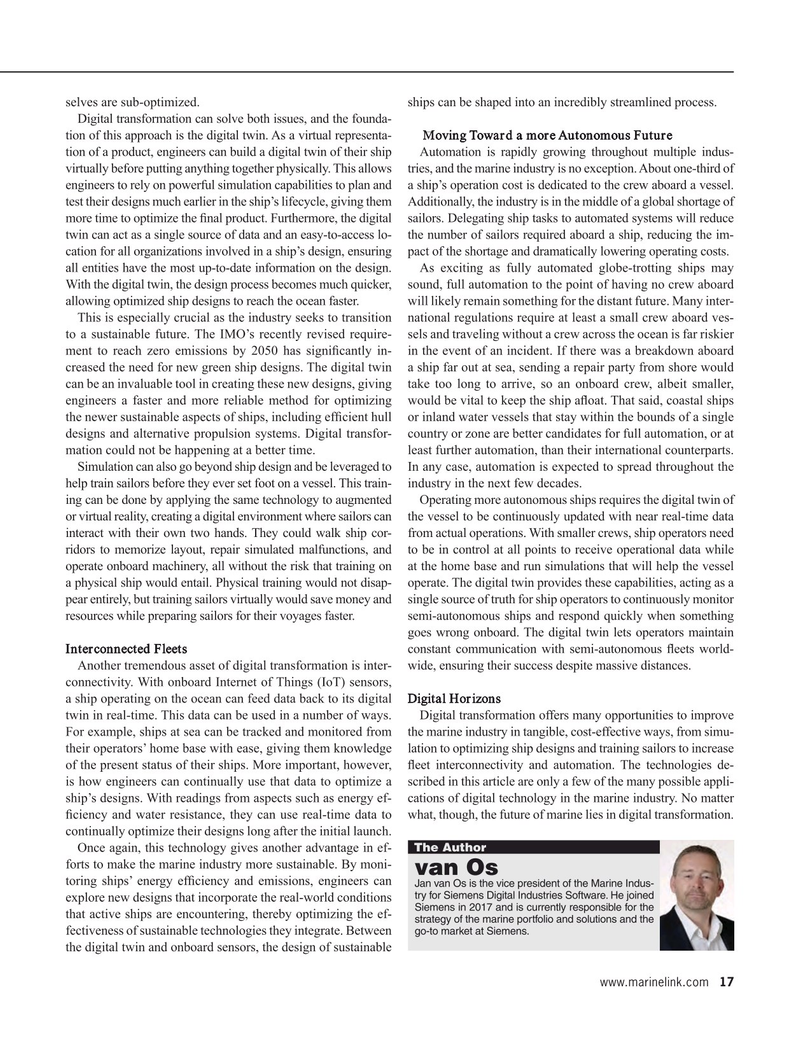
Page 17: of Maritime Reporter Magazine (December 2023)
Great Ships of 2023
Read this page in Pdf, Flash or Html5 edition of December 2023 Maritime Reporter Magazine
selves are sub-optimized. ships can be shaped into an incredibly streamlined process.
Digital transformation can solve both issues, and the founda- tion of this approach is the digital twin. As a virtual representa- Moving Toward a more Autonomous Future tion of a product, engineers can build a digital twin of their ship Automation is rapidly growing throughout multiple indus- virtually before putting anything together physically. This allows tries, and the marine industry is no exception. About one-third of engineers to rely on powerful simulation capabilities to plan and a ship’s operation cost is dedicated to the crew aboard a vessel. test their designs much earlier in the ship’s lifecycle, giving them Additionally, the industry is in the middle of a global shortage of more time to optimize the ? nal product. Furthermore, the digital sailors. Delegating ship tasks to automated systems will reduce twin can act as a single source of data and an easy-to-access lo- the number of sailors required aboard a ship, reducing the im- cation for all organizations involved in a ship’s design, ensuring pact of the shortage and dramatically lowering operating costs.
all entities have the most up-to-date information on the design. As exciting as fully automated globe-trotting ships may
With the digital twin, the design process becomes much quicker, sound, full automation to the point of having no crew aboard allowing optimized ship designs to reach the ocean faster. will likely remain something for the distant future. Many inter-
This is especially crucial as the industry seeks to transition national regulations require at least a small crew aboard ves- to a sustainable future. The IMO’s recently revised require- sels and traveling without a crew across the ocean is far riskier ment to reach zero emissions by 2050 has signi? cantly in- in the event of an incident. If there was a breakdown aboard creased the need for new green ship designs. The digital twin a ship far out at sea, sending a repair party from shore would can be an invaluable tool in creating these new designs, giving take too long to arrive, so an onboard crew, albeit smaller, engineers a faster and more reliable method for optimizing would be vital to keep the ship a? oat. That said, coastal ships the newer sustainable aspects of ships, including ef? cient hull or inland water vessels that stay within the bounds of a single designs and alternative propulsion systems. Digital transfor- country or zone are better candidates for full automation, or at mation could not be happening at a better time. least further automation, than their international counterparts.
Simulation can also go beyond ship design and be leveraged to In any case, automation is expected to spread throughout the help train sailors before they ever set foot on a vessel. This train- industry in the next few decades.
ing can be done by applying the same technology to augmented Operating more autonomous ships requires the digital twin of or virtual reality, creating a digital environment where sailors can the vessel to be continuously updated with near real-time data interact with their own two hands. They could walk ship cor- from actual operations. With smaller crews, ship operators need ridors to memorize layout, repair simulated malfunctions, and to be in control at all points to receive operational data while operate onboard machinery, all without the risk that training on at the home base and run simulations that will help the vessel a physical ship would entail. Physical training would not disap- operate. The digital twin provides these capabilities, acting as a pear entirely, but training sailors virtually would save money and single source of truth for ship operators to continuously monitor resources while preparing sailors for their voyages faster. semi-autonomous ships and respond quickly when something goes wrong onboard. The digital twin lets operators maintain
Interconnected Fleets constant communication with semi-autonomous ? eets world-
Another tremendous asset of digital transformation is inter- wide, ensuring their success despite massive distances.
connectivity. With onboard Internet of Things (IoT) sensors, a ship operating on the ocean can feed data back to its digital Digital Horizons twin in real-time. This data can be used in a number of ways. Digital transformation offers many opportunities to improve
For example, ships at sea can be tracked and monitored from the marine industry in tangible, cost-effective ways, from simu- their operators’ home base with ease, giving them knowledge lation to optimizing ship designs and training sailors to increase of the present status of their ships. More important, however, ? eet interconnectivity and automation. The technologies de- is how engineers can continually use that data to optimize a scribed in this article are only a few of the many possible appli- ship’s designs. With readings from aspects such as energy ef- cations of digital technology in the marine industry. No matter ? ciency and water resistance, they can use real-time data to what, though, the future of marine lies in digital transformation.
continually optimize their designs long after the initial launch.
The Author
Once again, this technology gives another advantage in ef- forts to make the marine industry more sustainable. By moni- van Os toring ships’ energy ef? ciency and emissions, engineers can
Jan van Os is the vice president of the Marine Indus- try for Siemens Digital Industries Software. He joined explore new designs that incorporate the real-world conditions
Siemens in 2017 and is currently responsible for the that active ships are encountering, thereby optimizing the ef- strategy of the marine portfolio and solutions and the go-to market at Siemens.
fectiveness of sustainable technologies they integrate. Between the digital twin and onboard sensors, the design of sustainable www.marinelink.com 17
MR #12 (1-17).indd 17 12/5/2023 11:17:07 AM

 16
16

 18
18
